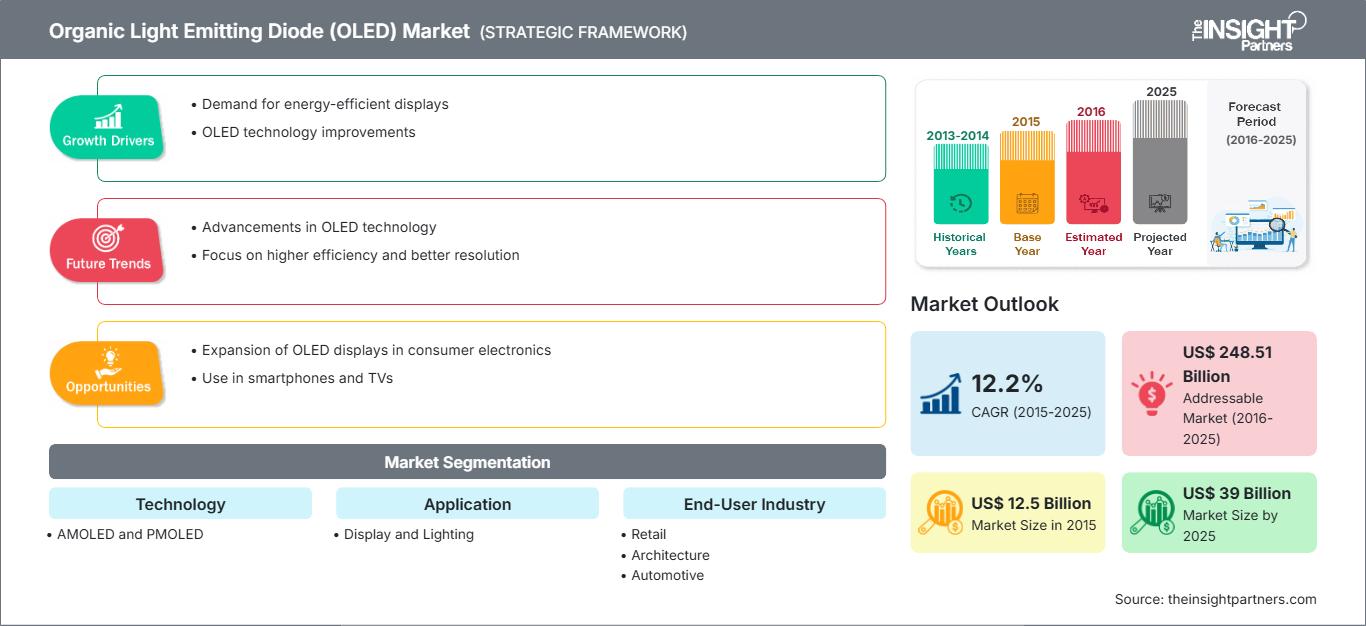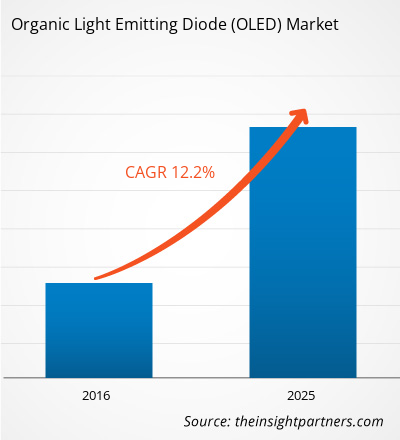2015 年有机发光二极管 (OLED) 市场价值为 125 亿美元,预计到 2025 年将达到 390 亿美元;预计 2015 年至 2025 年的复合年增长率为 12.2%。
OLED 由聚合物制成,通电后会发光。OLED 的应用领域十分广泛,例如零售、安防、汽车、建筑等。OLED 技术广泛应用于各种消费电子产品,包括手机显示屏、蓝牙耳机、车载音响显示屏、手持游戏机、MP3 播放器、数码相机以及许多其他工业应用。OLED 的两个主要应用领域是照明和显示。目前,柔性OLED发展最为活跃的三个地区是东亚、欧洲和北美。
有机发光二极管 (OLED) 市场机遇持续增长,各方正在进行大量资本投资,以促进未来几年产品价格更具竞争力。目前市场上的OLED显示器价格仍然昂贵,但随着技术的进步,价格有望下降。目前显示器性能的提升提高了产品竞争力,预计对小型显示器(尤其是智能手机)的需求将快速增长。而对于大型显示器市场,预计在不久的将来对配备OLED显示器的平板电视的需求将会增长。
OLED市场按地域划分,可分为北美、欧洲、亚太地区、南美和中东及非洲地区。包括绿色技术在内的节能显示器的生产正在推动几乎所有地区OLED市场的增长。随着公众对环保产品意识的增强,索尼、苹果、飞利浦和三星等公司正在利用OLED提高显示器的效率。由于液晶屏和等离子屏能耗较高,生产商也在研发能耗更低、更灵活的OLED显示屏。目前全球OLED市场格局表明,亚太地区占据主导地位,其次是北美。LG Display和三星Display是两家主要的OLED显示屏制造公司,主要集中在韩国,两家公司都在持续致力于提升产能和生产大尺寸OLED面板。除上述公司外,大多数OLED显示屏制造公司都位于亚太地区,尤其是台湾和中国大陆,并正在大力投资OLED面板的研发,旨在通过降低制造成本来提高生产效率。随着新公司投资OLED制造业务的涌现以及OLED技术的最新进展,预计预测期内OLED面板市场将进一步增长。
市场洞察:微型显示器在各个垂直领域的应用日益普及
显示技术已成为我们日常生活中不可或缺的一部分。微显示器是一种极小的显示器,对角线长度小于 25 毫米。这些显示单元具有放大显示单元使用的高分辨率和高密度屏幕。微显示器大约在二十年前推出。微显示器应用于各个垂直行业,例如工业、商业、航空航天、军事、汽车、医疗、执法和救援。微显示器主要用于军事和航空航天的 HMD 和 HUD。Micro-OLED 是向军事和航空航天垂直行业提供基于 OLED 的微显示器的先驱。这些显示单元提高了图像分辨率并降低了功耗。
基于类型的市场洞察
有机发光二极管 (OLED) 在电流改变时会发光。这些器件主要由聚合物和其他有机小分子组成,并且在平板显示器中具有多种应用前景,可以取代过时的阴极射线管 (CRT) 技术。全球 OLED 市场主要分为两类;无源矩阵有机发光二极管 (PMOLED) 和有源矩阵有机发光二极管 (AMOLED)。
基于应用的市场洞察
全球有机发光二极管市场根据应用细分为 OLED 显示器和 OLED 照明。OLED 用于生产电视屏幕、电脑显示器以及手持游戏机、手机和 PDA 等便携式设备中的数字显示屏。OLED 显示器能够显示深黑色,并且由于没有背光,因此比 LCD 更轻更薄。OLED 灯由夹在两个电极之间的半导体材料组成。OLED 是绿色、蓝色和红色薄膜薄层的组合,可发出更柔和的白光。
基于最终用户的市场洞察
OLED 的灵活性使制造商能够使用卷对卷制造工艺来生产 OLED,并能够生产柔性照明和显示产品。 OLED 的商业化生产是在刚性玻璃基板上进行的。不过,诸如弯曲显示器或采用柔性 OLED 的手表等应用最近也已进入市场。要开发出足够灵活且耐用的 OLED,需要进一步开发生产工艺和工具,并采用更优质的材料。全球 OLED 市场根据终端用户垂直领域细分为零售照明、安防和标牌、汽车、消费品、建筑和其他领域(工业、食品、医疗等)。
自定义此报告以满足您的要求
您将免费获得任何报告的定制,包括本报告的部分内容,或国家级分析、Excel 数据包,以及为初创企业和大学提供超值优惠和折扣
有机发光二极管(OLED)市场: 战略洞察

- 获取本报告的主要市场趋势。这个免费样本将包括数据分析,从市场趋势到估计和预测。
您将免费获得任何报告的定制,包括本报告的部分内容,或国家级分析、Excel 数据包,以及为初创企业和大学提供超值优惠和折扣
有机发光二极管(OLED)市场: 战略洞察

- 获取本报告的主要市场趋势。这个免费样本将包括数据分析,从市场趋势到估计和预测。
产品开发是企业扩展产品组合的常用策略。欧司朗、OLEDWORKS、LG、Acuity Brands 等公司是实施战略的关键参与者,旨在扩大客户群并在全球有机发光二极管 (OLED) 市场中占据显著份额,从而维护其品牌声誉。近期的一些重要进展包括:
- 2014 年,双叶株式会社宣布与模具和塑料成型产品制造商和销售商三光合成株式会社建立资本和业务联盟。这将有助于该公司开发新产品和新技术、增加订单和开拓市场、共享设施以及分享管理和生产经验。
- 2016 年 2 月,三星宣布该公司正在开发 OLED 电视面板,并投资约 30 亿美元用于 OLED 电视生产。
有机发光二极管(OLED)市场区域洞察
The Insight Partners 的分析师已详尽阐述了预测期内影响有机发光二极管 (OLED) 市场的区域趋势和因素。本节还讨论了北美、欧洲、亚太地区、中东和非洲以及南美和中美洲的有机发光二极管 (OLED) 市场细分和地域分布。
有机发光二极管(OLED)市场报告范围
| 报告属性 | 细节 |
|---|---|
| 市场规模 2015 | US$ 12.5 Billion |
| 市场规模 2025 | US$ 39 Billion |
| 全球复合年增长率 (2015 - 2025) | 12.2% |
| 历史数据 | 2013-2014 |
| 预测期 | 2016-2025 |
| 涵盖的领域 |
By 技术
|
| 覆盖地区和国家 | 北美
|
| 市场领导者和主要公司简介 |
|
有机发光二极管 (OLED) 市场参与者密度:了解其对业务动态的影响
有机发光二极管 (OLED) 市场正在快速增长,这得益于终端用户需求的不断增长,而这些需求又源于消费者偏好的不断变化、技术进步以及对产品优势的认知度不断提升等因素。随着需求的增长,企业正在扩展产品线,不断创新以满足消费者需求,并抓住新兴趋势,从而进一步推动市场增长。

- 获取 有机发光二极管(OLED)市场 主要参与者概述
- 无源矩阵有机发光二极管 (PMOLED)
- 有源矩阵有机发光二极管 (AMOLED)。
有机发光二极管 (OLED) 市场 - 按应用
- OLED 显示器
- OLED 照明
有机发光二极管 (OLED) 市场 - 按最终用户
- 零售照明
- 安全与标牌
- 汽车
- 消费产品
- 建筑
- 其他
有机发光二极管 (OLED) 市场 - 公司简介
- LG Display
- 三星显示有限公司
- 双叶株式会社
- 环球显示株式会社
- 铼德科技株式会社
- 欧司朗有限公司
- OLEDWorks LLC
- 群创光电株式会社
- 精工爱普生株式会社
- Acuity Brands Lighting Inc.
- 荷兰皇家飞利浦公司
- 历史分析(2 年)、基准年、预测(7 年)及复合年增长率
- PEST和SWOT分析
- 市场规模、价值/数量 - 全球、区域、国家
- 行业和竞争格局
- Excel 数据集
近期报告
客户评价
购买理由
- 明智的决策
- 了解市场动态
- 竞争分析
- 客户洞察
- 市场预测
- 风险规避
- 战略规划
- 投资论证
- 识别新兴市场
- 优化营销策略
- 提升运营效率
- 顺应监管趋势




















 获取免费样品 - 有机发光二极管(OLED)市场
获取免费样品 - 有机发光二极管(OLED)市场